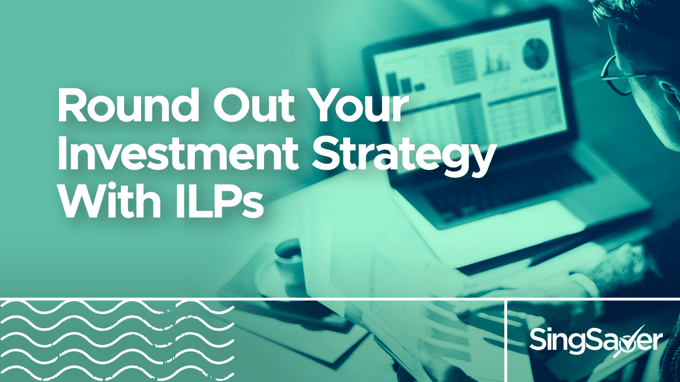You’ve seen the investment memes about rockets and moons. Now, find out where ILPs fit into your portfolio and how they might work for you.
Singaporeans are already a financially savvy bunch, but COVID-19 and the ensuing recession caused everyone to scrutinise their finances. Whether it’s saving more, getting greater insurance coverage, or investing better, every household definitely felt the urge to act.
With regards to investing, Singaporeans are familiar with the usual asset classes of equities, fixed income, and commodities. And who can forget cryptocurrency coming out of left field to dominate headlines?
However, there’s one investment that continues to mystify folks living in the Lion City: Investment-linked Insurance Policies (ILPs).
The irony here is that most people would’ve heard of ILPs before, especially if they’ve purchased an insurance policy or two from their trusted financial advisor.
What’s unclear would be the purpose that ILPs serve. Where exactly do these policies fit into your wealth accumulation strategy?
Before we dive into that part of wealth accumulation, let’s first explore what your money can be invested in.
- Equities
- Fixed income
- Commodities
- Investment-linked Policies
- Which ILP should I invest in?
- Conclusion
Equities: Owning part of a company
Simply put, equities refer to a company’s stocks and shares. In a wealth accumulation strategy, equities grant a high level of liquidity and diversify your investment portfolio across sectors and geographies.
Equities also allow investors to grow their wealth at a relatively quick pace. For example, 100 shares of tech giant Microsoft would be worth US$8,550 at the start of 2018. In September 2021, an identical number of shares would be worth almost 250% more, at US$29,647.
Unfortunately, not every publicly-traded company performs as well as Microsoft on a consistent basis. In this case, you could cast your sights to equity ETFs.
Fixed income: Lending money to a government or corporation
Fixed income is much less risky than equities. Essentially, this refers to bonds, treasury bills, and other debt instruments that are usually disbursed by governments and corporations.
Returns are disbursed in two forms, with the first being the principal sum credited back once the fixed income security matures. The second would be through regular interest payouts.
Fixed income allows investors to balance out their portfolio with a low-risk asset that grants stable returns. This is especially important for retirees, who should be prioritising wealth preservation instead of wealth accumulation.
Commodities: Goods that are vital to people and industries
Commodities are an easy asset class to understand because these are goods that people and industries utilise regularly. For example, crops, livestock, and precious metals. These are essential for our daily activities and for companies to operate smoothly.
Realistically, most of our commodity investments would consist of purchasing gold. The precious metal’s place in your wealth accumulation strategy is a safe haven if the markets are volatile or experiencing an extended downturn.
What’s more, you’re not limited to actual gold if you’d like to invest in it, with gold ETFs and shares of gold mining companies available for purchase too.
Investment-linked Policies: Investment and insurance combined
Despite the reputation that ILPs have in Singapore, they’re not as nefarious as they might seem. These policies are best purchased at a young age, acting as a vehicle for long-term wealth accumulation while providing a level of protection against income loss.
Returns aren’t guaranteed, but your financial advisor will be able to help you out when it comes to selecting the right sub-funds. Determine your risk appetite, discuss your financial goals, and you’re well on the way to selecting the appropriate sub-funds.
ILPs are highly flexible, depending on the sub-fund that you select. As each insurer has a variety of sub-funds you can invest in, ILPs can easily work alongside any other asset in your existing investment portfolio.
If you have a portfolio that’s heavy on equities for example, you can choose a sub-fund that invests in fixed income instruments. Alternatively, you can select a sub-fund that’s higher in risk if your current assets consist primarily of bonds, gold, and cash.
Unfortunately, traditional ILPs aren’t perfect. There are several bugbears that investors cite; with the sheer number of fees being the biggest one. As you can see from the diagram above, there are 12 sets of fees in total, which will eat into your returns no matter how you slice it.
Secondly, ILPs may have restrictive lock-in periods, which makes this a highly illiquid investment. In the event that you need cash quickly, you’ll need to look elsewhere instead.
Which ILP should I invest in, then?
Ideally, one that does away with all the hassle of investing in a traditional ILP. For instance, Tiq Invest, a digital ILP by Etiqa Insurance.
Take fees and charges, for example. Tiq Invest only levies a 0.75% management charge fee per annum. There are no insurance fees imposed either, but you do need to take note of fund-level charges that range from 0% to 4% p.a.
Fortunately, these fund-level fees are factored into the daily unit prices, with no bid-offer spread charges that most ILPs out there levy.
Signing up for Tiq Invest is a breeze too, because it’s all done through Tiq’s website.
There’s no need to seek out a financial advisor and you can even utilise Singpass Myinfo to automatically fill in your personal particulars.
From there, select an investment portfolio (Tiq Invest calls these ‘Packaged Funds’) and get it going by making a cash deposit via PayNow. It’s really that simple. You can then monitor its performance through the TiqConnect web platform or Tiq mobile app.
Speaking of deposits and withdrawals, Tiq Invest does away with penalty fees for early withdrawals. Additionally, there are no lock-in periods for deposits too. If you need money urgently, you can make a withdrawal without worrying about any miscellaneous charges or hoops to jump through.
And when it comes to ILP sub-funds, Tiq Invest selects from some of the best fund managers in the business. To be precise, there are five ILP sub-funds that the digital ILP invests in, depending on which packaged fund you select.
These are:
| Fund Manager | BlackRock | Dimensional Fund Advisors Ltd | PIMCO Global Advisors | Lion Global Investors Limited | PIMCO Global Advisors |
| ILP sub-fund | Asian Tiger Bond Fund | Global Short Fixed Income Fund | Global Investment Grade Credit Fund | Infinity Global Stock Index Fund | Emerging Markets Bond Fund |
| Objective | Maximising total return | Maximising current income whilepreserving capital | Maximising total return, consistent withpreservation of capital and prudent investment management | Medium to long-term capital appreciation | Maximising total return, consistent withprudent investment management |
| What the ILP sub-fund invests in | Mostly in fixed income transferable securities from issuers in Asian Tiger countries | High quality, fixed or floating rateinvestment-grade short term instruments | Mostly in a diversified portfolio of investment-grade corporate fixed income instruments | Vanguard® Global Stock Index Fund | Mostly in fixed income instruments of issuers that economically are tied to countries with emergingsecurities markets |
| Performance (since inception) | + 4.9% | + 1.69% | + 5.03% | + 3.8% | + 6.7% |
| Performance accurate as of | 30 June 2021 | 31 July 2021 | 31 July 2021 | 31 July 2021 | 31 July 2021 |
Table is derived from the fund factsheets of the respective ILP sub-funds. More information is available here.
Each packaged fund invests in these ILP sub-funds in varying proportions, with the exception of the Aggressive fund. That particular packaged fund invests 100% of your deposits into the Infinity Global Stock Index Fund, which is fantastic if your existing assets largely consist of commodities or fixed income investments.
If your existing investment portfolio is a combination of safe and risky assets instead, fret not. You can complement it by investing in either the Conservative, Moderate, or Growth packaged funds, depending on your risk appetite and investment horizon.
Conclusion
| Investment | Equities | Fixed Income | Commodities | Investment-linked Policies |
| Example | Stocks, shares, equity ETFs | Bonds, treasury bills, bond ETFs | Gold, crops, crude oil | Tiq Invest |
| Place in wealth accumulation strategy | High-risk investment with a potential for high returns High liquidity |
Low-risk investment with regular payouts Wealth preservation |
Safe haven when markets are volatile or bearish | Grows your wealth and complements existing insurance coverage Plays the role of equities or both equities and fixed income, depending on packaged funds chosen |
As you can see from the table above, every investment out there has a role to play in your wealth accumulation strategy. The proportion that you’d invest in each asset depends on your financial situation and goals.
Where an ILP comes into play would be… well, wherever you want it to.
ILPs are indeed that flexible. Depending on the sub-fund(s) that you choose, your ILP can play the role of equities, fixed income, or a combination of both. Through Tiq Invest’s four packaged funds, you can decide which one fits into your existing investment portfolio best.
You can even switch between packaged funds at no cost if your financial situation changes.
Therefore, ILPs grow your wealth while simultaneously bolstering your insurance coverage. For Tiq Invest, your loved ones will receive a lump sum payout that’s 105% of your net premiums or account value should you pass on or contract a terminal illness.
It’s a worthy add-on to your existing whole life or term life insurance policies.
Tech-savvy individuals will also appreciate that sign-ups can be done with a single click or tap. And all the information that you need regarding Tiq Invest is available on the Tiq website; there’s no need to contact a financial advisor.
Plus, you won’t run the risk of being persuaded to invest in a sub-fund that doesn’t align with your goals.
That’s a win-win situation right there.
This article was written in partnership with Tiq by Etiqa Insurance.
Tiq Invest is underwritten by Etiqa Insurance Pte. Ltd. (Company Reg. No. 201331905K).
Tiq Invest is an Investment-linked Plan (ILP) which invests in ILP sub-fund(s). Investments in this plan are subject to investment risks including the possible loss of the principal amount invested. The performance of the ILP sub-fund(s) is not guaranteed and the value of the units in the ILP sub-fund(s) and the income accruing to the units, if any, may fall or rise. Past performance is not necessarily indicative of the future performance of the ILP sub-fund(s).
A product summary and product highlights sheet(s) relating to the ILP sub-fund(s) are available and may be obtained from us via www.tiq.com.sg/product/tiqinvest. A potential investor should read the product summary and product highlights sheet(s) before deciding whether to subscribe for units in the ILP sub-fund(s).
As buying a life insurance policy is a long-term commitment, an early termination of the policy usually involves high costs and the surrender value, if any, that is payable to you may be zero or less than the total premiums paid. You should seek advice from a financial adviser before deciding to purchase the policy. If you choose not to seek advice, you should consider if the policy is suitable for you.
This content is for reference only and is not a contract of insurance.
Full details of the policy terms and conditions can be found in the policy contract.
This policy is protected under the Policy Owners’ Protection Scheme which is administered by the Singapore Deposit Insurance Corporation (SDIC). Coverage for your policy is automatic and no further action is required from you. For more information on the types of benefits that are covered under the scheme as well as the limits of coverage, where applicable, please contact us or visit the Life Insurance Association (LIA) or SDIC web-sites (www.lia.org.sg or www.sdic.org.sg).
This advertisement has not been reviewed by the Monetary Authority of Singapore.
Information is accurate as of 3 November 2021.
Read these next:
Guide To Investment-Linked Policies (ILP): What You Need To Know
What Are Mutual Funds, And How to Pick The Best Mutual Funds In Singapore 2021
What Are Fixed Income Investments, And How They Fit Into Your Portfolio
Beginner’s Guide To CPF Retirement Sums And How To Get There (2021)
So You Have a Messy Investment Portfolio. Here’s How You Can Clean it Up
Similar articles
Debunking The Myth Of Investment–linked Policies (ILP)
6 Ways An Investment-Linked Policy Can Play a Part in Your Recession-Proof Strategy
Is It Time to Fire Your Financial Advisor? These 5 Signs Say Yes
This Is How Par Policies’ Reduced Illustrative Rate Of Returns Affects You
5 Questions You Were Too Embarrassed to Ask About Mutual Funds
ILP Versus Whole Life Insurance: What’s the Difference?
8 Ways To Accelerate Your Wealth In Singapore
Wary of ILPs? Here’s How Singlife’s Sure Invest Is Challenging That










